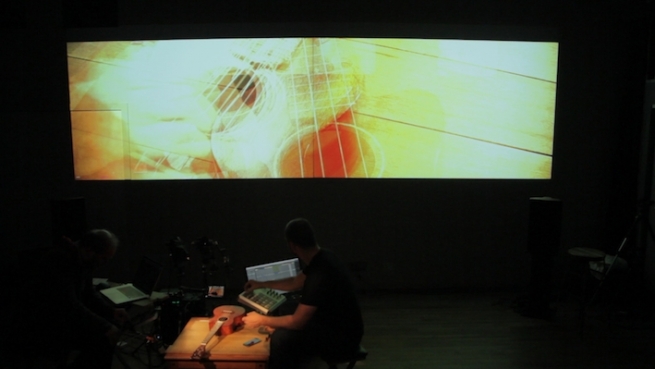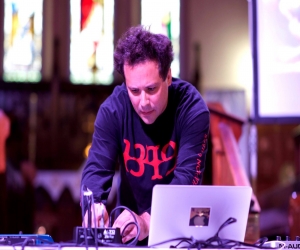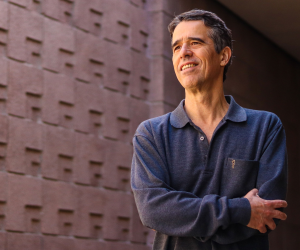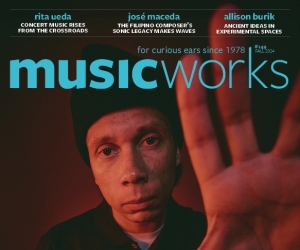
“I had never seen such new things before. I didn’t even know what a new object could be,” the poet and art critic André Salmon wrote, after visiting the studio of Pablo Picasso in the spring of 1914. Of particular interest to Salmon was Guitar, a wall-mounted 3-D collage of a semi-exploded guitar built with sheet metal and wire. More volumetric than a canvas and lacking the structural integrity to place on a plinth, the flayed form transcended both painting and sculpture. Salmon knew he had laid eyes on the future. Cubism changed how we see the world. And while the major Cubist works are now preserved in museums, the movement’s core question endures: what universe of permutational aesthetics resides within a single object or moment?
This question is central to Montreal-based collective Artificiel, known for its unconventional performances and ingenious scenography. Artists Alexandre Burton, Julien Roy, and Jimmy Lakatos formed Artificiel in 2003, with the creation and exhibition of condemned_bulbes (2003), a large installation that reveals the latent musicality lurking within incandescent light bulbs. Their 2006 piece cubing foregrounded the reconfigurability and play of the Rubik’s Cube, turning the puzzle’s machinations into a squelchy synthesizer. With POWEr (2009), Artificiel supersized its quasi-scientific experiments and fired up a Tesla coil, making the dangerous spark-blasting device the star soloist in a crackling concert.
“For us, making the system is part of the work,” Burton says, over Skype. “Our practice includes asking difficult questions and figuring out a solution . . . what we invent becomes new territory to explore.”
Three Pieces With Titles, Burton and Roy’s latest invention, premieres at MUTEK Montréal in August 2017. Burton calls it an audiovisual sampler: “Using foot pedals, we can sample whatever is under a central camera and play it back with sound.” A pencil and paper, a violin, a prism—selected objects at hand become media controllers, triggering major and minor elements within a composition and synchronized live video. While far more tangible than the comparatively sterile knobs, sliders, patch cords, and trackpads that abound at an electronic music festival, it is more than an improvisational platform on which to cut loose. Burton says the system builds on hard-learned lessons: for obvious reasons, the high voltage Tesla coil used in POWEr was hands-off and so compromises had to be made in terms of fidelity and control. “We are bringing back the notion of using stage presence and the gesture to be the motivation of the sound generator.”
Three Pieces With Titles contains, unsurprisingly, three movements: an introduction that marinates terse violin and alto bow strikes samples in brooding resonance, an intricate foray into musique concrète, and a wall-of-sound climax. Burton is keen to chat about the penultimate sequence, which features the most rigorous live sampling of objects and “sort of tumbles into rhythmic patterns” while pushing the system to its limits. “There’s a tricky aspect to the live loops we create . . . say we add ten samples and then trigger ten loops and adjust the speed and gaps between repetitions. We can create a very complicated polyrhythmic space—but then we’re stuck in it,” explains Burton. He and Roy have spent much of the last year finessing their system so it hits the right balance between fluidity (improvisatory bits are woven into preplanned sequences) and rigidity (escape hatches are available, should the duo get stuck in a recursive-loop maelstrom).
Much has changed in computer vision since cubing, in which Artificiel used softVNS running in Max to hermetically scrutinize a single object; Three Pieces With Titles relies on OpenFrameworks for processing camera input and driving video (synchronized with a Csound orchestra) to contemplate a bespoke inventory. “The system provides us with an idea of where the centre and edges of the object in front of the camera are, and measures how these readings change over time. It also captures colour information so we can ignore certain colours, or have different objects with different colours that are applied to distinct musical outcomes.”
While computer vision has evolved rapidly, there are some much slower-moving (and darker) currents of technical determinism at play here. A mood board of some of the imagery that will be processed by Artificiel’s object studies reveals a sinister catalogue of World War II-era research. Grinning Manhattan Project scientists, the half-assembled ellipsoid casing of the atomic bomb that was detonated over Nagasaki, eerie labs—trace evidence of the nascent military-industrial complex. Burton underscores that he and Roy have little interest in a documentary-style exploration and that they are just trying to capture the era’s essence. “It was quite a weird moment in history. Things were happening on a scale that is unattainable today.” But there are resonances (contemporary geopolitics certainly has us glancing nervously at the Doomsday Clock again) so perhaps there is a perpetual recurrence of sorts at play here.
Three Pieces With Titles may look back to those that split the atom for thematic inspiration, but the much more overt allusion is to those that blew up the fixity of objects and exploded singular things into myriad possibilities.
FYI: Montreal collective Artificiel’s Three Pieces With Titles will be created live via a new, real-time, audiovisual instrument that merges cameras, synthesizers, acoustic instruments, computers, and video projectors.
Top photo: Artificiel’s Alexandre Burton and Julien Roy at work in an early exploration of their latest invention. Three Pieces With Titles is commissioned by MUTEK, where it premieres August 25, 2017.


